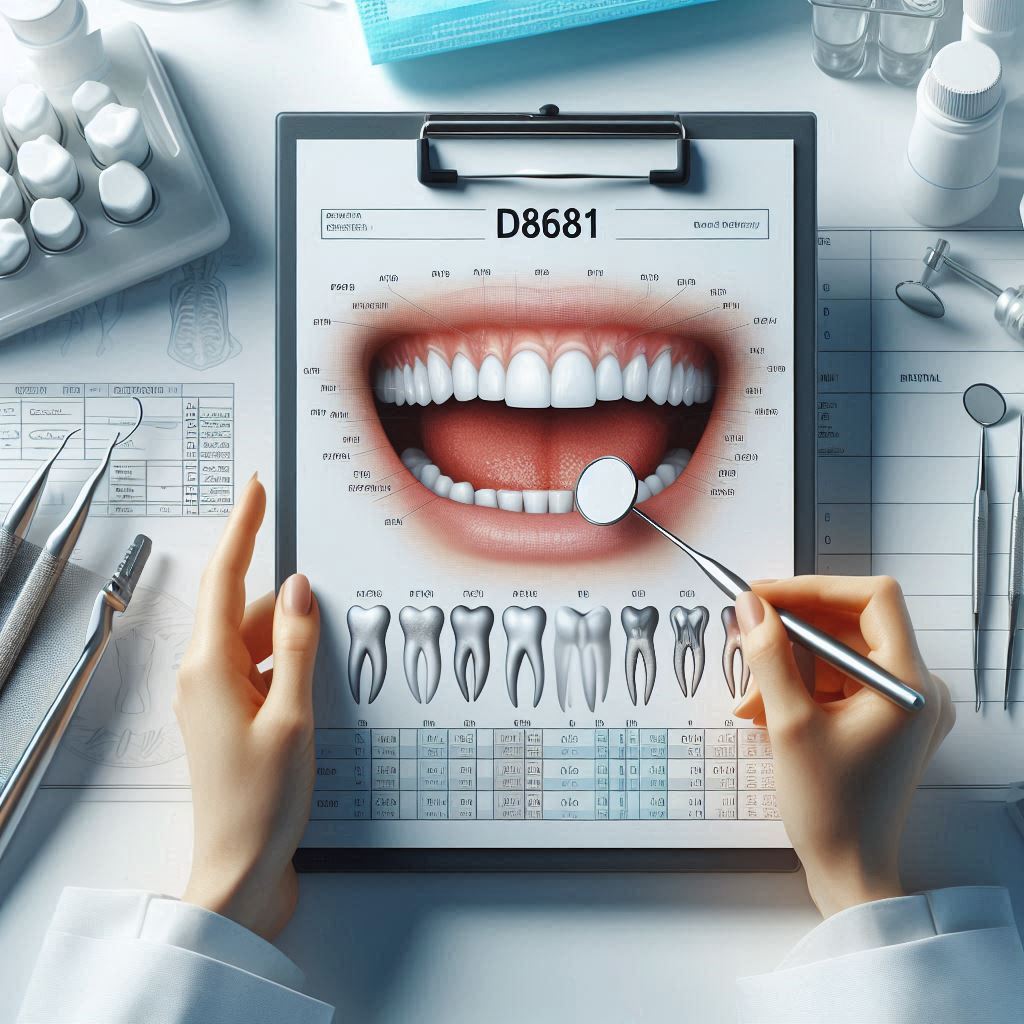D8681 Dental Code: Orthodontic Retention Procedures
Orthodontic treatment doesn’t end when braces come off—retention is a crucial phase that ensures teeth remain in their corrected positions. The D8681 dental code is specifically used for orthodontic retention procedures, covering the placement and follow-up of retainers after active orthodontic treatment.
This article provides an in-depth exploration of the D8681 code, including its clinical applications, insurance considerations, types of retainers, and best practices for long-term success. Whether you’re a dental professional, a patient, or an insurance provider, understanding this code is essential for proper treatment planning and billing.

2. Understanding Orthodontic Retention
Retention is the phase of orthodontic treatment that prevents teeth from shifting back to their original positions. Even after braces or aligners have done their job, teeth have a natural tendency to relapse due to periodontal ligament memory, jaw growth changes, and oral habits.
Why is Retention Necessary?
- Prevents Relapse: Without retainers, teeth may gradually shift.
- Stabilizes Bone and Gums: The surrounding bone and gum tissues need time to adapt.
- Maintains Bite Alignment: Ensures long-term functional and aesthetic results.
How Long Should Retention Last?
- Short-Term Retention (6-12 months): Full-time retainer wear.
- Long-Term Retention (Indefinite): Nighttime wear to prevent gradual shifting.
3. Types of Orthodontic Retainers
Retainers fall into two main categories: removable and fixed.
A. Removable Retainers
| Type | Description | Pros | Cons |
|---|---|---|---|
| Hawley Retainer | Made of acrylic and metal wires | Adjustable, durable | Visible, may affect speech |
| Essix Retainer | Clear plastic, similar to aligners | Nearly invisible, comfortable | Less durable, may warp |
B. Fixed Retainers
- Bonded Retainers: A thin wire glued behind the teeth (usually lower incisors).
- Pros: No compliance needed, 24/7 retention.
- Cons: Harder to clean, may break.
4. When is D8681 Code Used?
The D8681 code is applied for:
- Initial retainer placement after braces or aligner treatment.
- Follow-up adjustments (e.g., wire tightening, replacement).
- Repairs due to damage or wear.
D8681 vs. Other Orthodontic Codes
| Code | Description |
|---|---|
| D8670 | Monthly orthodontic adjustment (active treatment) |
| D8680 | Orthodontic retention (removable retainer) |
| D8681 | Orthodontic retention (fixed retainer) |
5. Clinical Procedures Covered Under D8681
Step-by-Step Process for Fixed Retainer Placement
- Teeth Preparation: Clean and etch bonding surfaces.
- Wire Selection: Choose appropriate gauge (usually .0175″ or .0195″).
- Bonding: Apply composite resin to secure the wire.
- Curing: Use a dental light to harden the adhesive.
- Final Check: Ensure no interference with bite.
6. Insurance Coverage and Reimbursement for D8681
- Coverage Varies: Some plans include retention, others consider it elective.
- Pre-Authorization Recommended: Verify benefits before treatment.
- Frequency Limits: Some insurers cover only one retainer per arch per lifetime.
7. Best Practices for Long-Term Retention Success
- Follow Dentist’s Instructions: Wear retainers as prescribed.
- Regular Check-Ups: Monitor for wear and stability.
- Good Oral Hygiene: Prevent decay around fixed retainers.
8. Potential Complications and How to Avoid Them
- Retainer Breakage: Avoid hard foods if wearing fixed retainers.
- Plaque Accumulation: Use floss threaders for bonded retainers.
- Speech Issues: Practice speaking with removable retainers.
9. Conclusion
The D8681 dental code is essential for orthodontic retention, ensuring teeth remain aligned post-treatment. Understanding its use, insurance implications, and best practices helps both providers and patients achieve lasting results. Retention is a lifelong commitment—proper care ensures a beautiful, functional smile for years.
10. Frequently Asked Questions (FAQs)
Q1: How often should I replace my retainer?
- Removable retainers last 2-5 years; fixed retainers may last longer but require monitoring.
Q2: Will insurance cover my retainer?
- Some plans do, but always check with your provider.
Q3: Can I whiten my teeth with a fixed retainer?
- Yes, but the wire may block whitening agents on bonded surfaces.
11. Additional Resources
- American Association of Orthodontists (AAO) – www.aaoinfo.org


